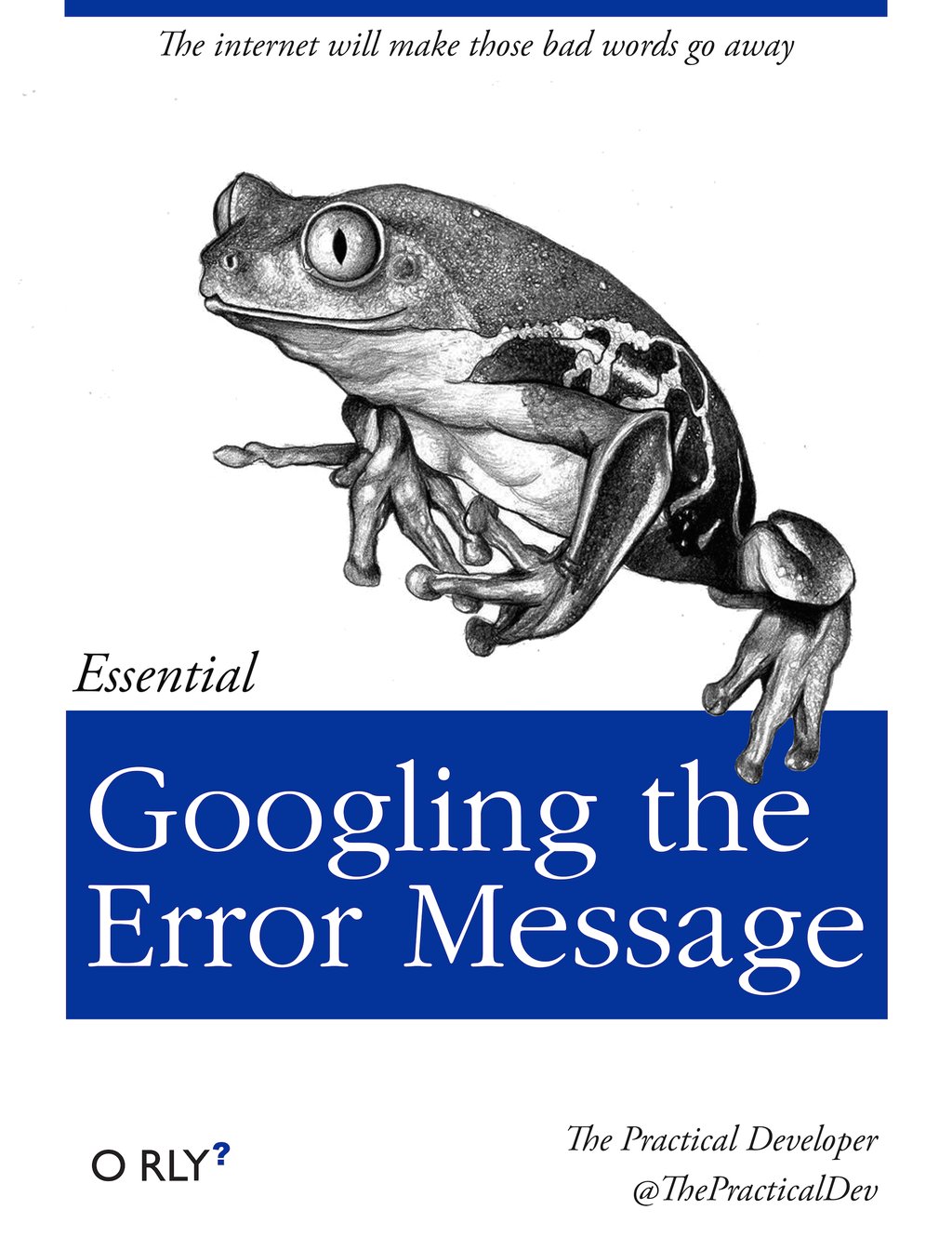# run in the console
# really basic examples
3*4
3+4
3-4
3/4Learning Objectives
- Get oriented with the RStudio interface
- Run code and basic arithmetic in the Console
- Practice writing code in an R Script
- Be introduced to built-in R functions
- Use the Help pages to look up function documentation
This lesson is a combination of excellent lessons by others. Huge thanks to Julie Lowndes for writing most of this content and letting us build on her material, which in turn was built on Jenny Bryan’s materials. We highly recommend reading through the original lessons and using them as reference (see in the resources section below).
3.1 Welcome to R Programming
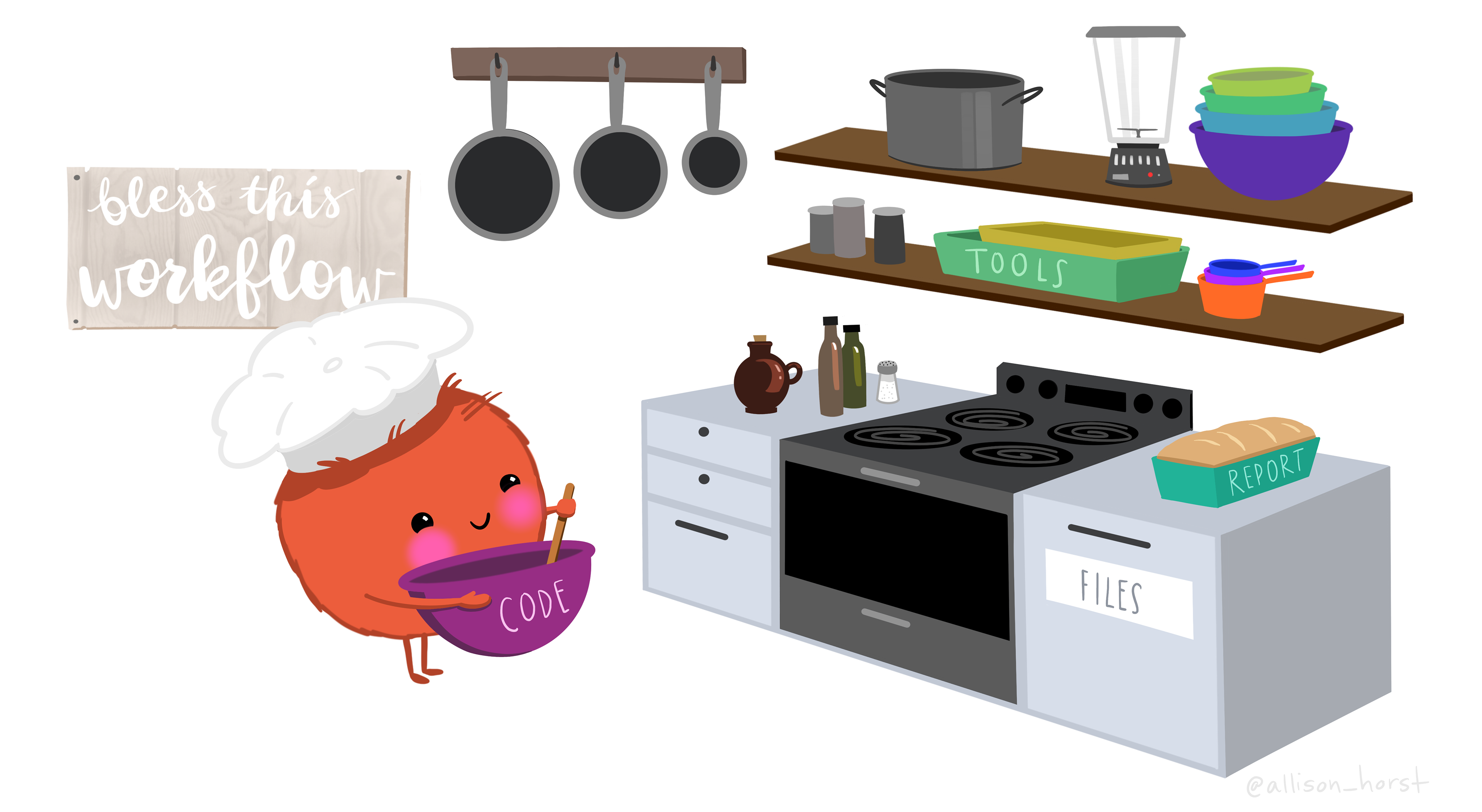
There is a vibrant community out there that is collectively developing increasingly easy to use and powerful open source programming tools. The changing landscape of programming is making learning how to code easier than it ever has been. Incorporating programming into analysis workflows not only makes science more efficient, but also more computationally reproducible. In this course, we will use the programming language R, and the accompanying integrated development environment (IDE) RStudio. R is a great language to learn for data-oriented programming because it is widely adopted, user-friendly, and (most importantly) open source!
So what is the difference between R and RStudio? Here is an analogy to start us off. If you were a chef, R is a knife. You have food to prepare, and the knife is one of the tools that you’ll use to accomplish your task.
And if R were a knife, RStudio is the kitchen. RStudio provides a place to do your work! Other tools, communication, community, it makes your life as a chef easier. RStudio makes your life as a researcher easier by bringing together other tools you need to do your work efficiently - like a file browser, data viewer, help pages, terminal, community, support, the list goes on. So it’s not just the infrastructure (the user interface or IDE), although it is a great way to learn and interact with your variables, files, and interact directly with git. It’s also data science philosophy, R packages, community, and more. Although you can prepare food without a kitchen and we could learn R without RStudio, that’s not what we’re going to do. We are going to take advantage of the great RStudio support, and learn R and RStudio together.
Something else to start us off is to mention that you are learning a new language here. It’s an ongoing process, it takes time, you’ll make mistakes, it can be frustrating, but it will be overwhelmingly awesome in the long run. We all speak at least one language; it’s a similar process, really. And no matter how fluent you are, you’ll always be learning, you’ll be trying things in new contexts, learning words that mean the same as others, etc, just like everybody else. And just like any form of communication, there will be miscommunication that can be frustrating, but hands down we are all better off because of it.
While language is a familiar concept, programming languages are in a different context from spoken languages and you will understand this context with time. For example: you have a concept that there is a first meal of the day, and there is a name for that: in English it’s “breakfast.” So if you’re learning Spanish, you could expect there is a word for this concept of a first meal. (And you’d be right: “desayuno”). We will get you to expect that programming languages also have words (called functions in R) for concepts as well. You’ll soon expect that there is a way to order values numerically. Or alphabetically. Or search for patterns in text. Or calculate the median. Or reorganize columns to rows. Or subset exactly what you want. We will get you to increase your expectations and learn to ask and find what you’re looking for.
3.2 RStudio IDE
Let’s take a tour of the RStudio interface.
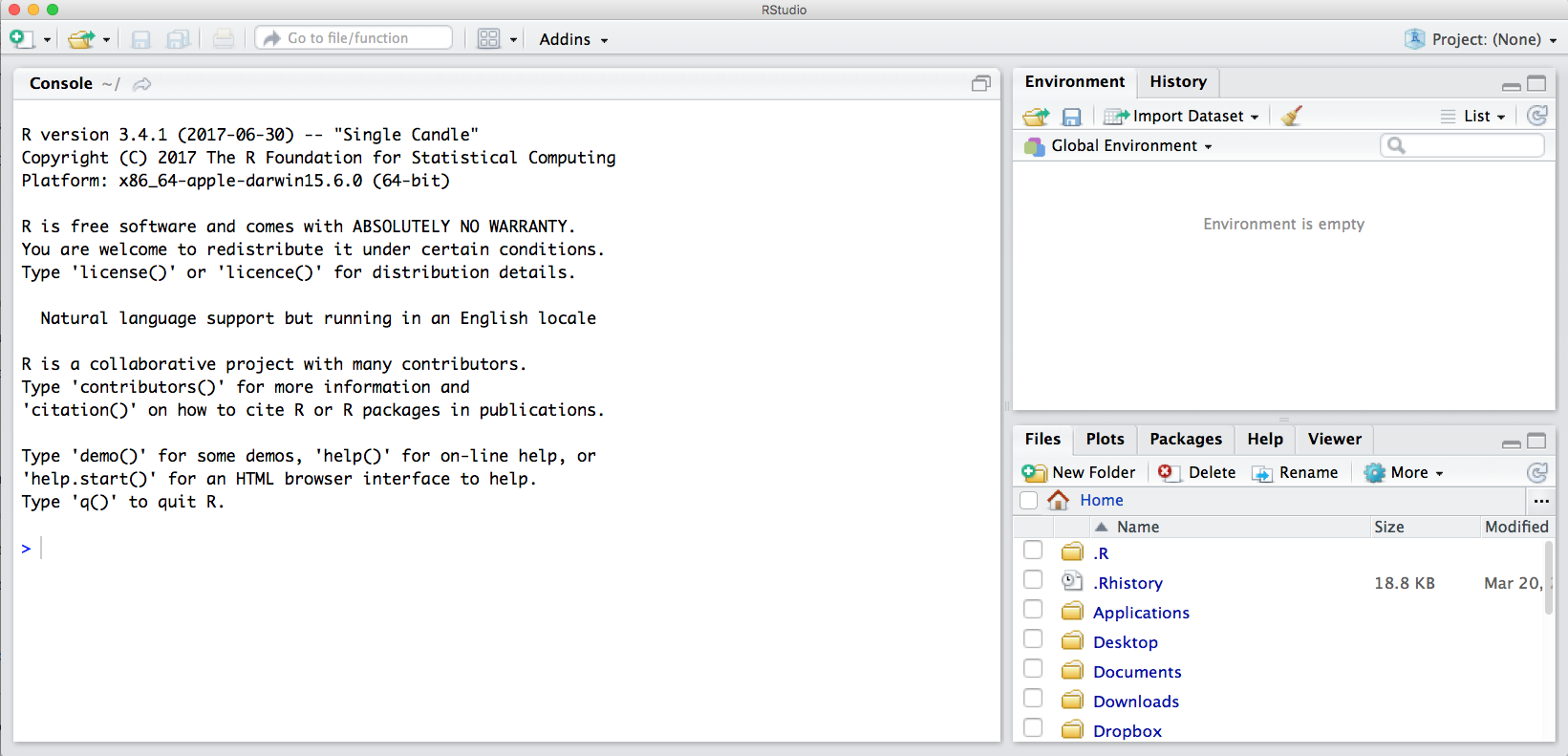
Notice the default panes:
- Console (entire left)
- Environment/History (tabbed in upper right)
- Files/Plots/Packages/Help (tabbed in lower right)
3.3 Coding in the Console
If you’ve just opened RStudio for the first time, you’ll be in your Home directory. This is noted by the ~/ at the top of the console. You can see too that the Files pane in the lower right shows what is in the Home directory where you are. You can navigate around within that Files pane and explore, but note that you won’t change where you are: even as you click through you’ll still be Home: ~/.
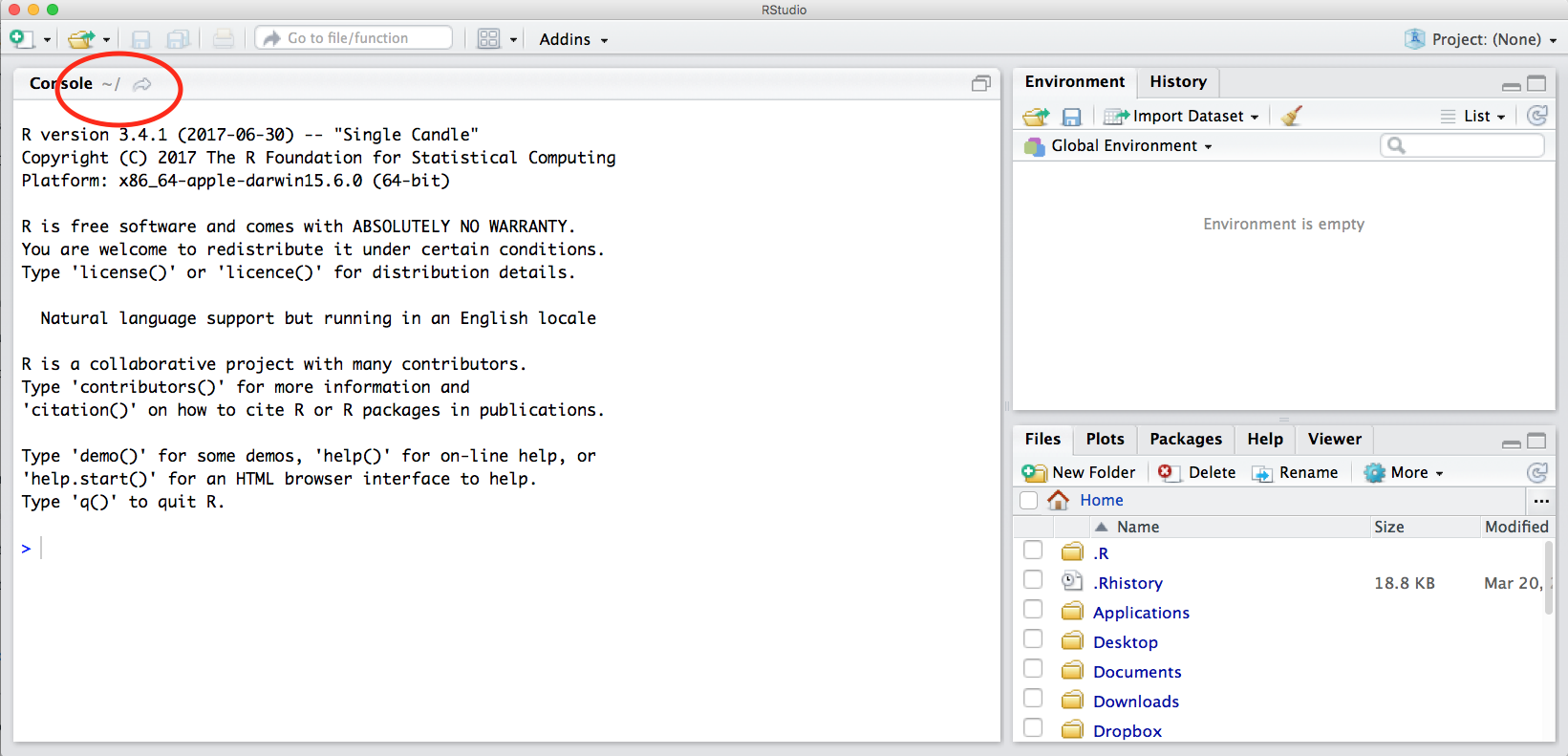
We can run code in a couple of places in RStudio, including the Console, let’s start there.
At it’s most basic, we can use R as a calculator, let’s try a couple of examples in the console.
While there are many cases where it makes sense to type code directly in to the the console, it is not a great place to write most of your code since you can’t save what you ran. A better way is to create an R Script, and write your code there. Then when you run your code from the script, you can save it when you are done. We’re going to continue writing code in the Console for now, but we’ll code in an R Script later in this lesson
3.3.1 Objects in R
Let’s say the value of 12 that we got from running 3*4 is a really important value we need to keep. To keep information in R, we need to create an object. The way information is stored in R is through objects.
We can assign a value of a mathematical operation (and more!) to an object in R using the assignment operator, <- (greater than sign and minus sign). All objects in R are created using the assignment operator, following this form: object_name <- value.
Assign 3*4 to an object called important_value and then inspect the object you just created.
# think of this code as someone saying "important_value gets 12".
important_value <- 3*4Notice how after creating the object, R doesn’t print anything. However, we know our code worked because we see the object, and the value we wanted to store is now visible in our Global Environment. We can force R to print the value of the object by calling the object name (aka typing it out) or by using parentheses.
# printing the object by calling the object name
important_value
# printing the object by wrapping the assignment syntax in parentheses
(important_value <- 3*4)3.3.2 Naming Conventions
Before we run more calculations, let’s talk about naming objects. For the object, important_value we used an underscore to separate the object name. This naming convention is called snake case. There are other naming conventions including, but not limited to:
we_used_snake_case
someUseCamelCase
SomeUseUpperCamelCaseAlsoCalledPascalCase
Choosing a naming convention is a personal preference, but once you choose one - be consistent! A consistent naming convention will increase the readability of your code for others and your future self.
3.4 Running code in an R Script
So far we’ve been running code in the Console, let’s try running code in an R Script. An R Script is a simple text file. RStudio uses an R Script by copying R commands from text in the file and pastes them into the Console as if you were manually entering commands yourself.
- From the “File” menu, select “New File”
- Click “R Script” from the list of options
RStudio should open your R Script automatically after creating it. Notice a new pane appears above the Console. This is called the Source pane and is where we write and edit R code and documents. This pane is only present if there are files open in the editor.
- Save the R Script as
intro-to-programming.R
3.4.1 How to run code in an R Script
Running code in an R Script is different than running code in the Console (aka you can’t just press return / enter). To interpret and run the code you’ve written, R needs you to send the code from the script (or editor) to the Console. Some common ways to run code in an R Script include:
Place your cursor on the line of code you want to run and use the shortcut
command+returnor click theRunbutton in the top right of the Source pane.Highlight the code you want to run, then use the shortcut
command+returnor click theRunbutton.
3.4.2 R calculations with objects
So we know that objects are how R stores information, and we know we create objects using the assignment operator <-. Let’s build upon that and learn how to use an object in calculations.
Imagine we have the weight of a dog in kilograms. Create the object weight_kg and assign it a value of 55.
# weight of a dog in kilograms
weight_kg <- 55 Now that R has weight_kg saved in the Global Environment, we can run calculations with it.
weight_kg run a simple calculation
Let’s convert the weight into pounds. Weight in pounds is 2.2 times the weight in kg.
# converting weight from kilograms to pounds
2.2 * weight_kgYou can also store more than one value in a single object. Storing a series of weights in a single object is a convenient way to perform the same operation on multiple values at the same time. One way to create such an object is with the function c(), which stands for combine or concatenate.
First let’s create a vector of weights in kilograms using c() (we’ll talk more about vectors in the next section, Data structures in R).
# create a vector of weights in kilograms
weight_kg <- c(55, 25, 12)
# call the object to inspect
weight_kgNow convert the vector weight_kg to pounds.
# covert `weight_kg` to pounds
weight_kg * 2.2Wouldn’t it be helpful if we could save these new weight values we just converted? This might be important information we may need for a future calculation. How would you save these new weights in pounds?
# create a new object
weight_lb <- weight_kg * 2.2
# call `weight_lb` to check if the information you expect is there
weight_lb3.5 Data types in R
| Data Type | Definition |
|---|---|
boolean (also called logical) |
Data take on the value of either TRUE, FALSE, or NA. NA is used to represent missing values. |
character |
Data are string values. You can think of character strings as something like a word (or multiple words). A special type of character string is a factor, which is a string but with additional attributes (like levels or an order). |
integer |
Data are whole numbers (those numbers without a decimal point). To explicitly create an integer data type, use the suffix L (e.g. 2L). |
numeric (also called double) |
Data are numbers that contain a decimal. |
| Data Type | Definition |
|---|---|
complex |
Data are complex numbers with real and imaginary parts. |
raw |
Data are raw bytes. |
We’ve been using primarily integer or numeric data types so far. Let’s create an object that has a string value or a character data type.
science_rocks <- "yes it does!"“yes it does!” is a string, and R knows it’s a word and not a number because it has quotes " ". You can work with strings in your data in R easily thanks to the stringr and tidytext packages.
This lead us to an important concept in programming: As we now know, there are different “classes” or types of objects in R. The operations you can do with an object will depend on what type of object it is because each object has their own specialized format, designed for a specific purpose. This makes sense! Just like you wouldn’t do certain things with your car (like use it to eat soup), you won’t do certain operations with character objects (strings).
Also, everything in R is an object. An object is a variable, function, data structure, or method that you have written to your environment.
Try running the following line in your script:
"Hello world!" * 3What happened? What do you see in the Console? Why?
3.6 Data structures in R
Okay, now let’s talk about vectors.
A vector is the most common and most basic data structure in R. Vectors can be thought of as a way R stores a collection of values or elements. Think back to our weight_lb vector. That was a vector of three elements each with a data type or class of numeric.
What we’re describing is a specific type of vector called atomic vectors. To put it simply, atomic vectors only contain elements of the same data type. Atomic vectors are very common.
Vectors are foundational for other data structures in R, including data frames, and while we won’t go into detail about other data structures there are great resources online that do. We recommend the chapter Vectors from the online book Advanced R by Hadley Wickham.
# atomic vector examples #
# character vector
chr_atomic_vector <- c("hello", "good bye", "see you later")
# numeric vector
numeric_atomic_vector <- c(5, 1.3, 10)
# logical vector
boolean_atomic_vector <- c(TRUE, FALSE, TRUE)3.7 R Functions
So far we’ve learned some of the basic syntax and concepts of R programming, and how to navigate RStudio, but we haven’t done any complicated or interesting programming processes yet. This is where functions come in!
A function is a way to group a set of commands together to undertake a task in a reusable way. When a function is executed, it produces a return value. We often say that we are “calling” a function when it is executed. Functions can be user defined and saved to an object using the assignment operator, so you can write whatever functions you need, but R also has a mind-blowing collection of built-in functions ready to use. To start, we will be using some built in R functions.
All functions are called using the same syntax: function name with parentheses around what the function needs in order to do what it was built to do. These “needs” are pieces of information called arguments, and are required to return an expected value.
Before we use a function, let’s talk about Help pages.
3.8 Getting help using help pages
What if you know the name of the function that you want to use, but don’t know exactly how to use it? Thankfully RStudio provides an easy way to access the help documentation for functions.
The next function we’re about to use is the mean() function.
To access the help page for mean(), enter the following into your console:
?meanThe Help pane will show up in the lower right hand corner of your RStudio.
The Help page is broken down into sections:
- Description: An extended description of what the function does.
- Usage: The arguments of the function(s) and their default values.
- Arguments: An explanation of the data each argument is expecting.
- Details: Any important details to be aware of.
- Value: The data the function returns.
- See Also: Any related functions you might find useful.
- Examples: Some examples for how to use the function.
And there’s also help for when you only sort of remember the function name: double-question mark:
??install 3.9 Examples using built-in R functions mean() and read.csv()
3.9.1 Use the mean() function to run a more complex calculation
Let’s override our weight object with some new values, and this time we’ll assign it three dog weights in pounds:
weight_lb <- c(55, 25, 12)mean() function to calculate the mean weight.
From the its Help page, we learned this function will take the mean of a set of numbers. Very convenient!
We also learned that mean() only has one argument we need to supply a value to (x). The rest of the arguments have default values.
Code
mean(x = weight_lb)mean_weight_lb
Hint: What operator do we use to save values to an object?
Code
# saving the mean using the assignment operator `<-`
mean_weight_lb <- mean(x = weight_lb)weight_lb
Let’s say each of the dogs gained 5 pounds and we need to update our vector, so let’s change our object’s value by assigning it new values.
Code
weight_lb <- c(60, 30, 17)Call mean_weight_lb in the console or take a look at your Global Environment. Is that the value you expected? Why or why not?
It wasn’t the value we expected because mean_weight_lb did not change. This demonstrates an important programming concept: Assigning a value to one object does not change the values of other objects.
Now, that we understand why the object’s value hasn’t changed - how do we update the value of mean_weight_lb? How is an R Script useful for this?
This lead us to another important programming concept, specifically for R Scripts: An R Script runs top to bottom.
This order of operations is important because if you are running code line by line, the values in object may be unexpected. When you are done writing your code in an R Script, it’s good practice to clear your Global Environment and use the Run button and select “Run all” to test that your R Script successfully runs top to bottom.
3.9.2 Use the read.csv() function to read a file into R
So far we have learned how to assign values to objects in R, and what a function is, but we haven’t quite put it all together yet with real data yet. To do this, we will introduce the function read.csv(), which will be in the first lines of many of your future scripts. It does exactly what it says, it reads in a csv file to R.
Since this is our first time using this function, first access the help page for read.csv(). This has a lot of information in it, as this function has a lot of arguments, and the first one is especially important - we have to tell it what file to look for. Let’s get a file!
- Navigate to this dataset by Craig Tweedie that is published on the Arctic Data Center. Craig Tweedie. 2009. North Pole Environmental Observatory Bottle Chemistry. Arctic Data Center. doi:10.18739/A25T3FZ8X.
- Download the first csv file called
BGchem2008data.csvby clicking the “download” button next to the file. - Move this file from your
Downloadsfolder into thedatadirectory we created in our R Projecttraining_{USERNAME}.
Now we have to tell read.csv() how to find the file. We do this using the file argument which you can see in the usage section in the help page. In R, you can either use absolute paths (which will start with your home directory ~/) or paths relative to your current working directory. RStudio has some great auto-complete capabilities when using relative paths, so we will go that route.
Assuming you have moved your file to a folder within training_{USERNAME} called data, and your working directory is your project directory (training_{USERNAME}) your read.csv() call will look like this:
# reading in data using relative paths
bg_chem_dat <- read.csv(file = "data/BGchem2008data.csv")You should now have an object of the class data.frame in your environment called bg_chem_dat. Check your environment pane to ensure this is true. Or you can check the class using the function class() in the console.
You can always specify arguments in name = value form. But if you do not, R attempts to resolve by position. So above, it is assumed that we want file = "data/BGchem2008data.csv", since file is the first argument.
If we explicitly called the file argument our code would like this:
bg_chem_dat <- read.csv(file = "data/BGchem2008data.csv")If we wanted to add another argument, say stringsAsFactors, we need to specify it explicitly using the name = value pair, since the second argument is header.
Many R users (including myself) will override the default stringsAsFactors argument using the following call:
# relative file path
bg_chem_dat <- read.csv("data/BGchem2008data.csv",
stringsAsFactors = FALSE)
# absolute file path
bg_chem_dat <- read.csv("Documents/arctic_training_files/data/BGchem2008data.csv",
stringsAsFactors = FALSE)3.10 Working with data frames in R using the Subset Operator $
A data.frame is a two dimensional data structure in R that mimics spreadsheet behavior. It is a collection of rows and columns of data, where each column has a name and represents a variable, and each row represents an observation containing a measurement of that variable. When we ran read.csv(), the object bg_chem_dat that we created is a data.frame. There are many ways R and RStudio help you explore data frames. Here are a few, give them each a try:
- Click on the word
bg_chem_datin the environment pane - Click on the arrow next to
bg_chem_datin the environment pane - Execute
head(bg_chem_dat)in the Console - Execute
View(bg_chem_dat)in the Console
Usually we will want to run functions on individual columns in a data.frame. To call a specific column, we use the list subset operator $.
Say you want to look at the first few rows of the Date column only:
head(bg_chem_dat$Date)You can also use the subset operator $ calculations. For example, let’s calculated the mean temperature of all the CTD samples.
mean(bg_chem_dat$CTD_Temperature)You can also save this calculation to an object using the subset operator $.
mean_temp <- mean(bg_chem_dat$CTD_Temperature)3.11 Error messages are your friends
There is an implicit contract with the computer/scripting language: Computer will do tedious computation for you. In return, you will be completely precise in your instructions. Typos matter. Case matters. Pay attention to how you type.
Remember that this is a language, not dissimilar to English! There are times you aren’t understood – it’s going to happen. There are different ways this can happen. Sometimes you’ll get an error. This is like someone saying ‘What?’ or ‘Pardon’? Error messages can also be more useful, like when they say ‘I didn’t understand this specific part of what you said, I was expecting something else’. That is a great type of error message. Error messages are your friend. Google them (copy-and-paste!) to figure out what they mean. Note that knowing how to Google is a skill and takes practice - use our Masters of Environmental Data Science (MEDS) program workshop Teach Me How to Google as a guide.
And also know that there are errors that can creep in more subtly, without an error message right away, when you are giving information that is understood, but not in the way you meant. Like if I’m telling a story about tables and you’re picturing where you eat breakfast and I’m talking about data. This can leave me thinking I’ve gotten something across that the listener (or R) interpreted very differently. And as I continue telling my story you get more and more confused… So write clean code and check your work as you go to minimize these circumstances!
3.12 R Packages

R packages are the building blocks of computational reproducibility in R. Each package contains a set of related functions that enable you to more easily do a task or set of tasks in R. There are thousands of community-maintained packages out there for just about every imaginable use of R - including many that you have probably never thought of!
To install a package, we use the syntax install.packages("packge_name"). A package only needs to be installed once, so this code can be run directly in the console if needed. Generally, you don’t want to save your install package calls in a script, because when you run the script it will re-install the package, which you only need to do once, or if you need to update the package.
3.13 R Resources
| Learning R Resources |
|
| Community Resources |
|
| Cheatsheets |
3.14 Bonus Content
3.14.1 Clearing the environment
Take a look at the objects in your Environment (Workspace) in the upper right pane. The Workspace is where user-defined objects accumulate. There are a few useful commands for getting information about your Environment, which make it easier for you to reference your objects when your Environment gets filled with many, many objects.
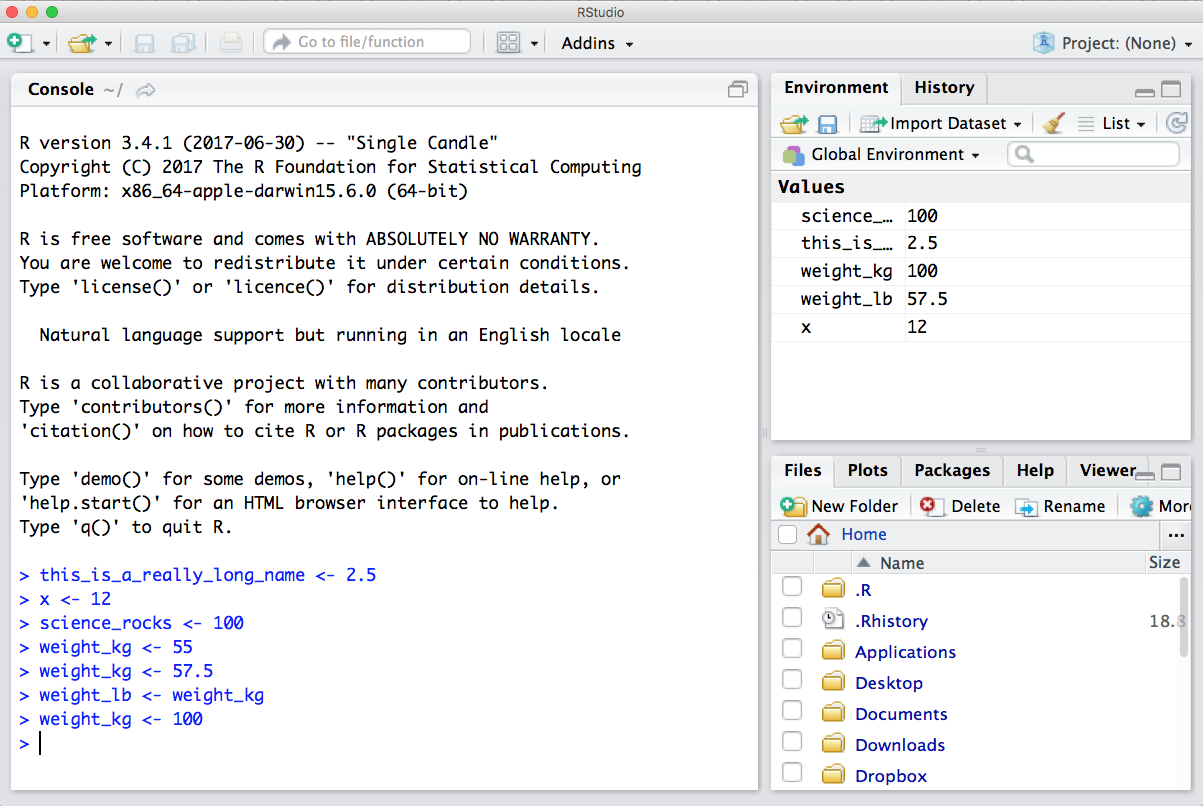
You can get a listing of these objects with a couple of different R functions:
objects()
ls()If you want to remove the object named weight_kg, you can do this:
rm(weight_kg)To remove everything (or click the Broom icon in the Environment pane):
rm(list = ls())3.14.2 Logical operators and expressions
We can ask questions about an object using logical operators and expressions. Let’s ask some “questions” about the weight_lb object we made.
==means ‘is equal to’!=means ‘is not equal to’<means ‘is less than’>means ‘is greater than’<=means ‘is less than or equal to’>=means ‘is greater than or equal to’
# examples using logical operators and expressions
weight_lb == 2
weight_lb >= 30
weight_lb != 5